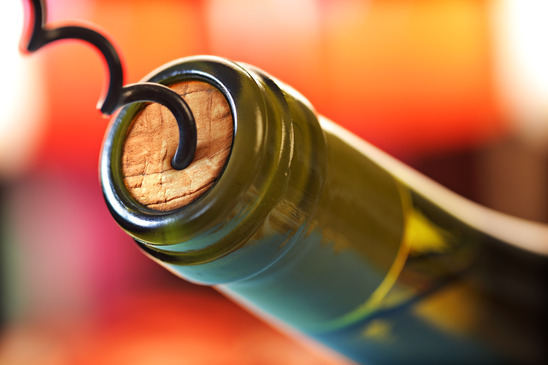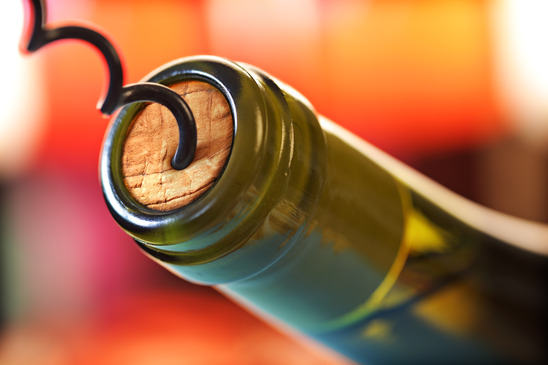
You may have noticed a trend appearing on wine store shelves. More winemakers are sealing bottles with screw caps instead of corks. And it’s not just cheap, inexpensive wine. Screw caps are appearing increasingly on more expensive bottles as well.
For winemakers, a lot goes into the decision of how to best seal a bottle, and cost of the materials is only part of the equation. They also need to consider whether a wine will be aged for more than five years, if it will be exposed to varying humidities and how much product they’re willing to sacrifice to cork taint.
So which is better: a screw top or a cork? Each has its benefits and issues.
Natural cork closures

The most traditional and elegant closure, the natural cork, is harvested from an evergreen oak tree. For those prized cellar bottles, natural cork is often considered to be the best option. Yet while this closure offers benefits, it has a few downsides as well.
Pros:
- There’s something seemingly unromantic about cracking the seal on a screw cap. The ritual of cutting the foil and popping a cork just feels like the “right” way to open a bottle.
- The nature of a cork seal allows for just a hint of oxidation, which permits wine to age and evolve in the bottle.
- When spending a fair amount of money on a special bottle, there’s something to be said for the ambiance of pulling a cork.
- Cork is a natural, renewable resource with no harmful side effects to humans.
Cons:
- If a wine isn’t bold enough handle more than five years of aging, the slight oxidation exposure from a natural cork is less than ideal. For the majority of wines sold in stores, five years of mild oxidation is actually a bad thing, as it will rush a wine past its peak and cause it to lose its flavor. This means most wines sealed with a cork should be consumed at least five years after bottling.
- Natural corks are prone to deterioration in the presence of some chemicals. If a winery cannot ensure its cellar is free of detrimental chemicals, natural cork may be a risky choice. Bleach cleaning products and contaminants found in wood crates and pallets can erode natural cork, exposing the bottled wine to disastrous bacteria and chemicals — and resulting in undesirable cork taint. It is estimated that between 1-5 percent of all wine made is lost to cork taint — a large financial loss for any winery.
- Natural cork is prone to contract and expand in temperature and humidity fluctuations. If a bottle is not stored properly, the cork can shrink and expose wine to oxidation and bacteria. However for collectors who maintain proper storage conditions, this could be considered a pro! You’ll know all your wines will be exposed to the correct temperature and humidity conditions, guaranteeing just the right amount of oxidation for aging.
Bottom line: Pure natural cork is best for wines you plan to age more than five years. But for wines you plan to drink immediately, the risks of cork closures may outweigh their benefits.
In addition to natural corks and screw caps, the wine closure industry has developed several other alternatives, none of which are perfect, summarized below.
Composite cork closures
Made from natural cork, these closures are easier to produce because they don’t require large, perfect pieces of bark. Composite is essentially scrap cork that is chopped up and fused together. It’s like the cork equivalent of plywood.
Pros:
- Composite is less expensive for winemakers, who hopefully then pass those savings on to their consumers.
- These function relatively similarly to whole cork, letting in roughly the same amount of oxidation.
Cons:
- Composite is prone to crumbling or breaking upon extraction. Because cork is prone to some drying and deterioration with time, the instability of composite makes it especially unsuitable for wines that need long-term aging.
- Composite has the same limitations as pure cork for wines that don’t need much oxidation — you’re forced to drink them young or be disappointed if you wait too long.
- There is a risk that glue and other unnatural materials can leech into the wine and may have unhealthful consequences long term.
Bottom line: Composites are fine for wines meant to be consumed young. They function similarly to a pure cork and won’t be likely to dry out in a short amount of time. But, they aren’t ideal for long-term cellaring.
Synthetic cork closures
Synthetic corks are made from a firm, waxy plastic foam and function somewhat similarly to natural cork in the short-term.
Pros:
- Synthetic is inexpensive, unlikely to crumble, and not as prone to drying out and expanding or contracting as its natural counterparts.
Cons:
- Synthetics don’t seal nearly as well as natural cork, meaning they allow too much unwanted oxidation — and quickly.
- They can be tricky to get out of the bottle.
- Like composite corks, synthetic corks are made from non-natural materials that may affect the wine and have long-term health effects.
Bottom Line: Synthetic cork should never be used for wines you plan to cellar. They won’t age well and synthetic corks don’t perform like a natural cork.
Screw cap closures
The much maligned screw-cap is seeing a bit of a renaissance, and for good reason. For the majority of wines on store shelves, it actually is the best seal! But it’s not perfect for all wines. Like corks, screw caps have their pros and cons.
Pros:
- A screw cap forms a nearly perfect seal, meaning wine will not become contaminated with bacteria or oxygen. Even if a chlorine cleaner comes into the cellar, a screw cap will hold up.
- The lower rates of tainted wine means screw caps save producers (and therefore consumers) considerable money.
- Screw caps are fairly inexpensive, meaning wine producers can focus their money into other avenues and even pass along some of the savings to consumers.
Cons:
- Screw caps are not ideal for long-term aging or for wines that need a little oxidation. Their perfect seal doesn’t allow any breathability at all, so they prevent wines from evolving and maturing.
- Screw caps can also be fragile. If the sealed cap is bumped up against something, the cap can dent, breaking the seal and allowing for oxidation and bacterial contamination.
Bottom line: For wines that are meant to be consumed young, the screw cap seems to be the best preserver. Screw caps don’t admit enough oxygen for long-term cellaring.
No closure is best for all wines
Natural corks are best for wines that need aging, such as most red wines. Ultimately, it can pay to be traditional when it comes to bottles you plan to cellar, especially when opening wine bottles with dramatic corkscrews like the popular Rogar Estate Wine Openers.
Screw caps are gaining popularity, particularly with white wine. They’re best suited for wines that will be consumed within one to three years. The benefit offered by eliminating cork taint as well as a lower production cost make screw-caps a smart choice for many small, boutique winemakers. Although if you’re still having a hard time imagining turning down the lights and listening to the sweet crack of a screw top by the fire, you’re not alone!
About the author: Rebecca Cox is a Chicago-based actress, wine lover and wine shop-girl. Check out her blog Chicago Uncorked to follow her thoughts on wine tasting, enology, viticulture and wine in the Windy City.
